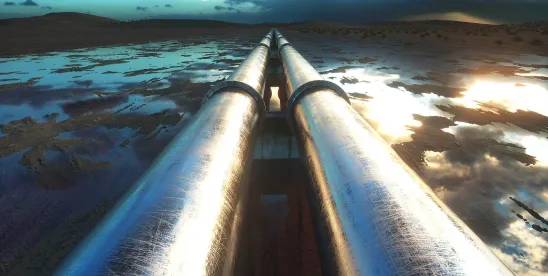On April 29, 2025, the Pipeline and Hazardous Safety Administration (PHMSA) released an Advanced Notice of Proposed Rulemaking (ANPRM) inviting stakeholder input on potential opportunities to amend existing pipeline safety regulations governing liquefied natural gas (LNG) facilities. The ANPRM does not propose regulatory changes. The feedback received will inform a future notice of proposed rulemaking (NPRM) that will contain specific proposals to revise existing regulations. Comments on the ANPRM will be due 60 days after it is published in the Federal Register.
BACKGROUND
PHMSA’s existing LNG safety regulations, found at 49 C.F.R. Part 193, establish requirements for the siting, design, installation, construction, inspection, testing, operation, and maintenance of LNG facilities. PHMSA has not substantially revised these regulations in over 20 years. The most recent significant amendment occurred in 2004 when most PHMSA-regulated LNG facilities were relatively small LNG import facilities and peak-shaving facilities. Part 193 also incorporates by reference many provisions of the 2001 edition of the National Fire Protection Association (NFPA) 59A. This industry standard has been updated multiple times since its incorporation into the regulations.
The ANPRM explains that the LNG industry has become increasingly important to the United States economy and that the country has become the largest international exporter of LNG. This transition has been marked by the construction of larger more capital-intensive LNG export terminals. In addition, LNG facility technologies and operations have evolved and domestic interest in small-scale or mobile or temporary LNG facilities to support novel applications has increased. These applications include marine bunkering for fueling maritime vessels, trucking fleet transportation fueling, alternative gas supply for pipeline testing activities, off-grid electric power and heat generation, and electric power continuity for data centers.
The ANPRM notes that policy makers and industry stakeholders have urged PHMSA to update the Part 193 regulations to keep pace with technological innovation and best practices. Updating LNG safety regulations also responds to President Trump’s recent executive orders requiring agencies to identify opportunities to alleviate unnecessary regulatory compliance burdens.
The ANPRM
This ANPRM initiates PHMSA’s renewed regulatory initiative to update its Part 193 LNG regulations. To inform future specific regulatory amendments, the ANPRM poses numerous questions addressing a range of topics. Most questions also request that stakeholders provide specific information and data about incremental costs and benefits. PHMSA requests per-unit, aggregate, and programmatic data, and explanations of the bases or methodologies used to generate such data.
Applicability of Part 193: The ANPRM inquires how PHMSA could improve or clarify the application of Part 193, whether amendments are needed to clarify the boundaries of PHMSA’s regulatory authority, and whether PHMSA’s evaluation of an LNG facility’s compliance with Part 193 should also consider the facility’s compliance with analogous regulatory requirements or guidance issued by other federal agencies that also have regulatory authority over the facility.
Characteristics of LNG Facilities: The ANPRM seeks information on the types and functions of LNG facilities projected to come on line over the next two decades, and whether any material differences in the characteristics of such facilities warrant that they be treated differently under Part 193.
Reporting Requirements: The ANPRM inquires whether any of the information required to be reported has limited safety value or is duplicative with information that is submitted to other regulatory authorities. The ANPRM also requests stakeholders to identify the incremental, per-unit costs and benefits associated with requiring that safety-related conditions be reported during commissioning and initial start-up of an LNG facility.
Incorporation of Industry Standards: Part 193 currently incorporates by reference much of NFPA 59A-2001. The ANPRM poses numerous questions about compliance issues and costs associated with this standard and the potential costs and benefits associated with incorporating some or all of NFPA 59A-2023. The ANPRM also inquires whether the safety value of any of PHMSA’s interpretations of its Part 193 regulations do not justify the associated compliance costs and whether any interpretations should be codified in Part 193.
The ANPRM also seeks information about other industry standards that are incorporated by reference in Part 193, as well as whether there are industry standards relevant to Part 193-regulated LNG facilities that are not incorporated into Part 193 but should be.
Risk-Based Regulatory Approach for Large-scale LNG Facilities: The PIPES Act of 2020 requires PHMSA to update the Part 193 regulations to provide for a “risk-based regulatory approach” for “large-scale” LNG facilities. PHMSA seeks comments on the appropriate metric and threshold for determining whether an LNG facility should be considered “large-scale.” The ANPRM also seeks input on which operations and maintenance regulations would be suitable for a risk-based alternative, and whether particular regulatory or conceptual frameworks or industry standards or protocols would be appropriate for designing implementation plans for an alternative risk-based regulatory approach.
Alleviating Regulatory Burdens: The ANPRM notes the recent executive orders directing PHMSA to reduce regulatory burdens on the U.S. energy industry. PHMSA seeks comments on aspects of it’s regulations that are particularly burdensome for the operation of LNG facilities, areas where additional regulatory text would reduce costs without adversely affecting safety, aspects of current regulations that are outdated or unnecessary because industry practice or industry guidelines constitute an equivalent or better standard for both cost savings and safety, and how PHMSA can best design a rulemaking to update Part 193 to be deregulatory and lead to cost savings for the industry.






 />i
/>i
